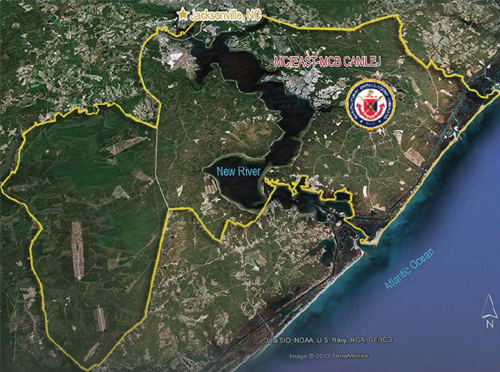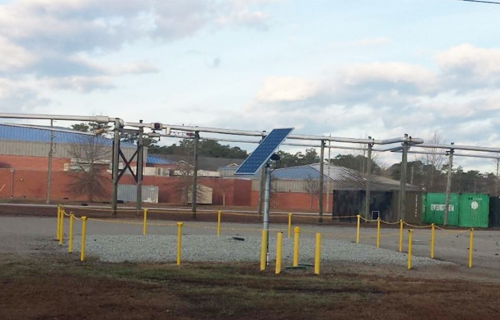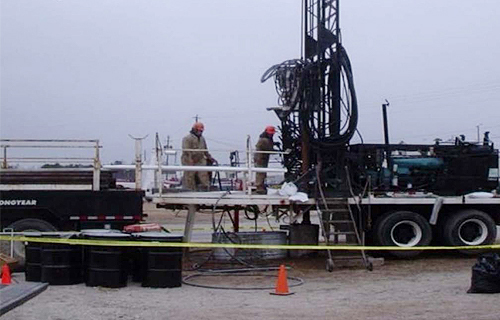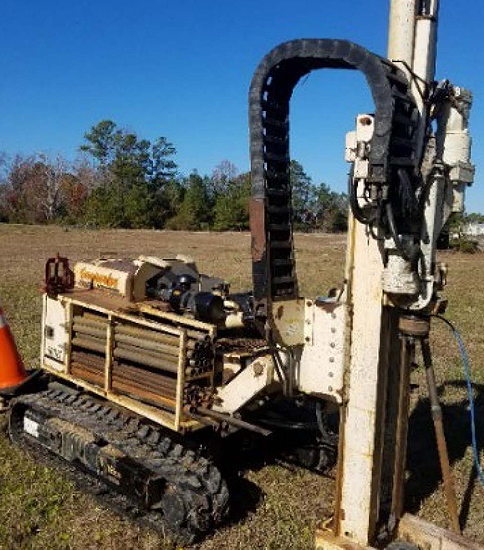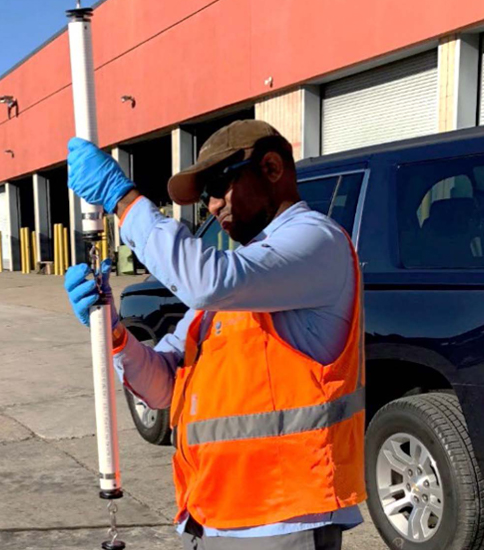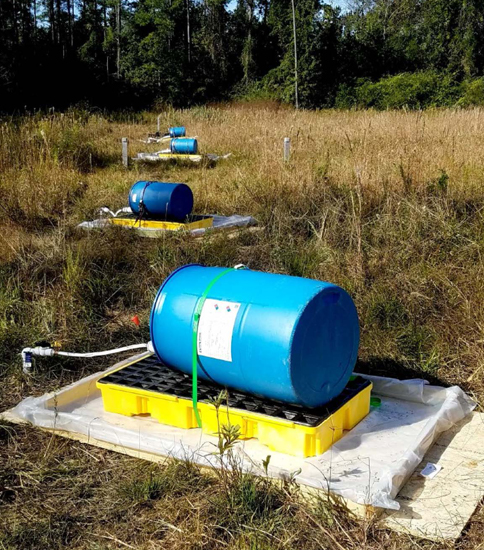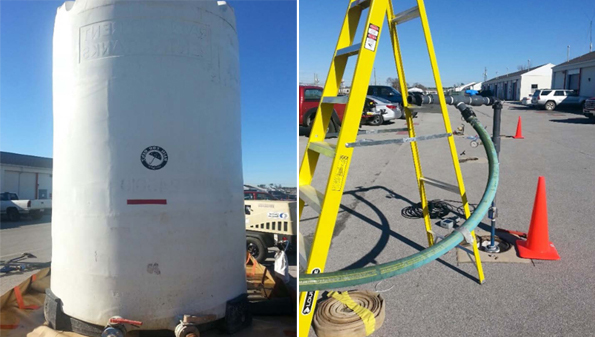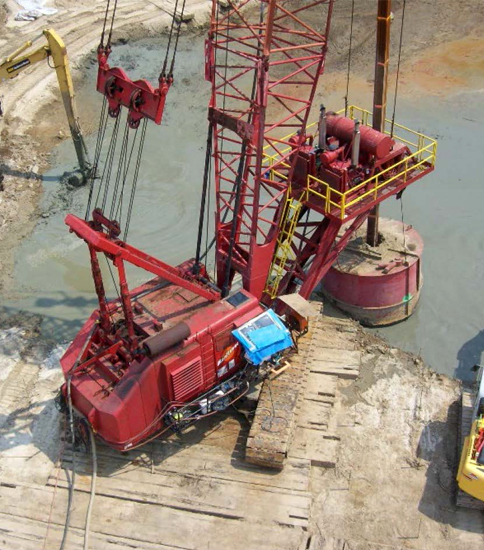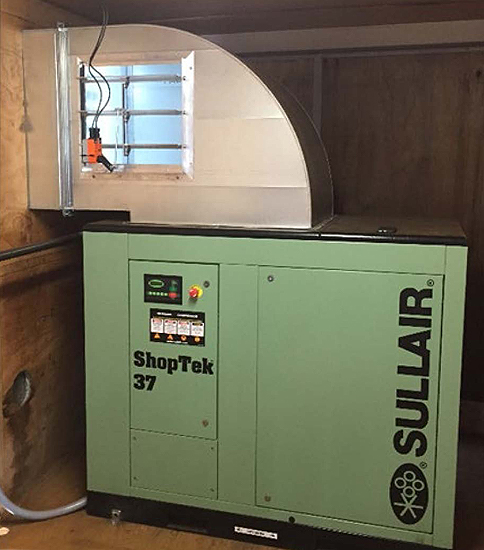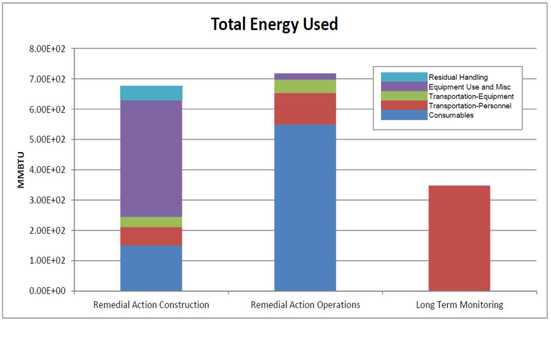Green Remediation Focus
Camp Lejeune Military Reservation
Onslow County, North Carolina
Federal Facility, Superfund NPL
Cleanup Objectives: Environmental cleanup at the 156,000-acre Camp Lejeune Military Reservation is underway at 42 CERCLA sites and 10 RCRA solid waste management units. The cleanup goals for contaminated soil, sediment, surface water or groundwater vary on a site-by-site basis. Remedies have included excavation and offsite disposal of contaminated soil, long-term groundwater extraction and treatment, and in situ technologies such as electrical resistance heating, enhanced reductive dechlorination (ERD) and chemical oxidation. Ongoing site activities of Marine Corps Base (MCB) Camp Lejeune and Marine Corps Air Station (MCAS) New River focus on training of military personnel and maintenance of combat-ready warfighters. The reservation is also used for industrial, recreational, commercial and residential purposes.
Green Remediation Strategy: The ASTM Standard Guide for Greener Cleanups (E2893-16) was applied to Installation Restoration Program actions completed during various cleanup phases between 2009 and 2017. Use of the guide involved evaluating best management practices (BMPs) for all relevant sites and quantitatively evaluating the cleanup footprint at 20 sites undergoing remedy selection or optimization. Screening of the 114 BMPs listed in the standard guide's "BMP table" identified 29 potentially applicable BMPs that were prioritized based on factors such as technical feasibility. The following BMPs were selected for implementation during one or more project stages.
General Planning and Site Investigation or Preparation
- Choose locally available subcontractors, staff, materials and equipment when feasible to minimize transportation-related fuel use and greenhouse gas emissions.
- Salvage single-use items that may be locally recycled.
- Minimize removal of downed trees and snags providing habitat for animal and plant species.
- Restrict traffic to confined corridors to minimize soil compaction and land disturbance.
- Use minimally invasive drilling methods when feasible to reduce drilling duration, avoid or minimize use of water, and prevent or reduce generation of cuttings and associated disposal of investigation-derived waste.
- Coordinate with state regulators in identifying site-specific opportunities to minimize environmental footprints of concern.
Site Assessment
- Use field test kits when feasible for contaminant screening analysis to minimize fuel and material usage associated with shipments to offsite laboratories.
- Choose a multi-port sampling system in monitoring wells to minimize the total number of wells needing to be installed.
- Use direct-sensing equipment to collect real-time data in non-invasive or minimally invasive manners.
Remedy Design and Implementation
- Use onsite sources of renewable energy to directly power remediation equipment.
- Use gravity flow rather than pumping processes to introduce amendments or chemical oxidants to the subsurface when high-pressure injection is unnecessary.
- Integrate automation equipment to minimize site worker transportation and optimize remedy operations.
- Reuse existing wells in lieu of constructing new wells wherever feasible for sampling, injection, extraction or monitoring purposes.
- Deploy passive no-purge sampling techniques to monitor groundwater.
- Minimize the slopes of landfill covers to reduce the volume of required fill material while providing sufficient drainage.
- Reclaim and reuse housing structures and equipment no longer needed for remediation purposes.
- Use biobased and non-refined materials rather than petroleum-based materials as substrates for implementing technologies intended to enhance contaminant degradation.
- Use industrial byproducts or waste instead of highly refined products to achieve desired chemical reactions in contaminated environmental media.
- Steam-clean or use phosphate-free detergents or biodegradable cleaning products instead of organic solvents or acids to decontaminate equipment such as drill rigs.
Results:
Energy Use & Air Emissions
- Avoided use of grid electricity and associated grid extension by installing a stand-alone solar array to operate a groundwater recirculation pump at Site 93. The pump supports a subsurface biogeochemical reactor containing mulch and 220 gallons of soybean oil. During construction of the reactor cell, about 45 cubic yards of uncontaminated soil were retained and used as backfill to reduce the amount of offsite backfill needed.
- Avoided use of liquid fuel to deliver 16,000 gallons of an ERD substrate into the subsurface at Site 78 by relying on gravity flow. The equivalent of two 1.5-horsepower pumps otherwise would have been operated over 13 hours to inject the substrate. The ERD substrate also was injected via gravity feed at Site 89.
- Avoided fuel consumption associated with installing 15 additional monitoring wells at Site 88 by utilizing multi-port sampling systems extending to six depth intervals within each of three wells, thereby reducing the collective drilling depth by approximately 1,800 feet. This approach also prevented associated material consumption, generation of an estimated 26 tons of soil waste requiring offsite disposal, and helped minimize land and ecosystem disturbance.
>Well Installation & Sampling
- Avoided generating an estimated 6,000 gallons of purge water during well sampling due to a 10-gallon reduction in the state-required purge volume for each low-flow well. This estimate assumes annual sampling at 200 low-flow wells over three years.
- Reduced purge water generation by an estimated 4,500 gallons by using passive sampling devices such as diffusion bags, Snap Samplers™ or HydraSleeves™ at 10 sites (Sites 6, 35, 36, 49, 69, 73, 78, 86, 89 and 93). This estimate assumes annual sample collection at 300 wells over three years and a purge-water savings of 5 gallons per well.
- Avoided approximately 100 feet of drilling by using four existing monitoring wells rather than constructing additional wells for persulfate injection pilot tests at solid waste management units (SWMUs) 43 and 177. This approach eliminated generation of an estimated 1.5 tons of waste soil and 400 gallons of wastewater, helped conserve fuel and material use, and prevented drilling-related impacts on existing ecosystems.
- Avoided consuming an estimated 45,000 feet (180 pounds) of low-density polyethylene tubing for groundwater sampling by using no-purge sampling devices with reusable hangers rather than purging techniques requiring low-flow tubing. This estimate assumes an average well depth of 50 feet and a three-year sampling period.
- Saved an estimated 27,600 gallons of potable water by using uncontaminated water from selected monitoring wells as dilution and chase water for injecting amendments to address an isolated volatile organic compound (VOC) plume in Site 35 groundwater. The amendments included 137 gallons of a biostimulation product and 1.8 liters of a bioaugmentation product, as well as 4.9 pounds of red yeast (rice) extract, a biobased source of statins capable of additionally stimulating anaerobic bacteria.
Materials & Waste Management
- Reduced generation of drilling-related waste soil by approximately 10 percent (65 tons) due to using rotosonic drilling methods. This estimate assumes an average of 1,500 feet of drilling per year for cleanup activities over three years.
- Avoided generating an estimated 2 tons of waste due to using a direct-sensing membrane interface probe (MIP) to evaluate the extent of chlorinated VOCs in the subsurface at Sites 6/82 and 78 instead of conducting extensive direct push technology (DPT) sampling. This estimate assumes that one DPT deployment would have been required for every two MIP locations and 33 DPT samples would have been collected to depths of 40 feet.
- Used additional biobased material rather than petroleum-based materials to replenish the Site 93 biogeochemical reactor and address vinyl chloride concentrations that continued to exceed cleanup levels after three years of operation. A total of 110 gallons of 100% food-grade soybean oil and 4 liters of bioaugmentation culture were injected into the existing piping.
- Mixed approximately 930 tons of zero valent iron (ZVI), a byproduct of steel recycling, instead of manufactured products as an ERD substrate into soil contaminated by VOCs at Sites 88 and 89. An emission extraction hood system was used to control emissions and nuisance odors resulting from the ZVI-VOC reaction.
- Offset the use of an estimated 25 tons of steel due to recovery and reuse of a steel conex box and steel equipment no longer used for air sparging activities at Site 73 and SWMU 350.
- Salvaged and transferred 19,000 pounds of acceptable metal materials at Sites UXO-06, UXO-17, UXO-19 and UXO-22 to a smelting facility. In addition, 5,000 pounds of salvaged scrap metal and 16 tons of salvaged concrete were transferred to recycling facilities.
- Retained trees greater than 3 inches in diameter in accordance with statements of work applying to site preparation. To avoid unnecessary subsurface disturbance and potential erosion, the stumps and root balls of larger trees and brush requiring removal were left in place and the felled vegetative material was mulched in place.
- Recycling an estimated 12 cubic yards of plastic, glass, paper and cardboard waste generated by fieldwork each year. The materials are collected at a field trailer and disposed of at the on-base recycling facility.
Property End Use: Ongoing military training and preparedness
Point of Contact: Jennifer Tufts, U.S. EPA Region 4; Thomas Richard, MCB Camp Lejeune; and Dave Cleland, U.S. Navy
Update: July 2021


